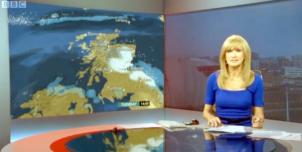Full Freeview on the Craigkelly (Fife, Scotland) transmitter
| Google Streetview | Google map | Bing map | Google Earth | 56.071,-3.234 or 56°4'17"N 3°14'1"W | KY3 9HW |
The symbol shows the location of the Craigkelly (Fife, Scotland) transmitter which serves 430,000 homes. The bright green areas shown where the signal from this transmitter is strong, dark green areas are poorer signals. Those parts shown in yellow may have interference on the same frequency from other masts.
This transmitter has no current reported problems
The BBC and Digital UK report there are no faults or engineering work on the Craigkelly (Fife, Scotland) transmitter._______
Digital television services are broadcast on a multiplexes (or Mux) where many stations occupy a single broadcast frequency, as shown below.
64QAM 8K 3/4 27.1Mb/s DVB-T MPEG2
DTG-12 QSPK 8K 3/4 8.0Mb/s DVB-T MPEG2
H/V: aerial position (horizontal or vertical)
Which Freeview channels does the Craigkelly transmitter broadcast?
If you have any kind of Freeview fault, follow this Freeview reset procedure first.Digital television services are broadcast on a multiplexes (or Mux) where many stations occupy a single broadcast frequency, as shown below.
64QAM 8K 3/4 27.1Mb/s DVB-T MPEG2
DTG-12 QSPK 8K 3/4 8.0Mb/s DVB-T MPEG2
H/V: aerial position (horizontal or vertical)
Which BBC and ITV regional news can I watch from the Craigkelly transmitter?

BBC Reporting Scotland 2.4m homes 9.2%
from Glasgow G51 1DA, 70km west-southwest (252°)
to BBC Scotland region - 230 masts.

STV News 0.5m homes 1.7%
from Edinburgh EH3 9QG, 14km south (174°)
to STV Central (Edinburgh) region - 8 masts.
Are there any self-help relays?
| Dullatur | Transposer | 20 km NE Glasgow | 40 homes |
| Edinburgh | Transposer | Sighthill area | 167 homes |
How will the Craigkelly (Fife, Scotland) transmission frequencies change over time?
| 1984-97 | 1997-98 | 1998-2011 | 2011-13 | 3 Oct 2018 | |||||
| A K T | K T | K T | K T | W T | |||||
| C21 | C4waves | C4waves | C4waves | +BBCB | BBCB | ||||
| C24 | ITVwaves | ITVwaves | ITVwaves | D3+4 | D3+4 | ||||
| C27 | BBC2waves | BBC2waves | BBC2waves | BBCA | BBCA | ||||
| C29 | SDN | ||||||||
| C30 | LEH | ||||||||
| C31 | BBC1waves | BBC1waves | BBC1waves | ArqA | |||||
| C32 | _local | ||||||||
| C33 | com7 | ||||||||
| C34 | com8 | ||||||||
| C37 | ArqB | ||||||||
| C39 | +ArqB | ||||||||
| C42 | SDN | ||||||||
| C45 | ArqA | ||||||||
| C48 | C5waves | C5waves | |||||||
| C55tv_off | com7tv_off | ||||||||
| C56tv_off | COM8tv_off |
tv_off Being removed from Freeview (for 5G use) after November 2020 / June 2022 - more
Table shows multiplexes names see this article;
green background for transmission frequencies
Notes: + and - denote 166kHz offset; aerial group are shown as A B C/D E K W T
waves denotes analogue; digital switchover was 1 Jun 11 and 15 Jun 11.
How do the old analogue and currrent digital signal levels compare?
| Analogue 1-4 | 100kW | |
| BBCA, D3+4, BBCB | (-7dB) 20kW | |
| com7, com8 | (-9.7dB) 10.8kW | |
| SDN, ARQA, ARQB | (-10dB) 10kW | |
| LEH | (-13dB) 5kW | |
| Analogue 5, Mux 1*, Mux 2*, Mux A*, Mux B* | (-14dB) 4kW | |
| Mux C*, Mux D* | (-17dB) 2kW |
Which companies have run the Channel 3 services in the Craigkelly transmitter area
|
|
Saturday, 18 June 2011
S
scott7:43 PM
Edinburgh
Missing all the ARQB channels since the rescan.Using a Samsung SIR-200IM box.
| link to this comment |
scott's: mapS's Freeview map terrainS's terrain plot wavesS's frequency data S's Freeview Detailed Coverage
B
brian8:04 PM
Broxburn
Hi there in Broxburn here, I have a loft arial, prior to switch over I received all channels from Craigkelly transmitter, now we no longer receive stv, 4, 5, sky news and the HD channels and possibly few others. Would my best bet be to wait until 22nd and try Blackhill also? Or will I have to consider buying a wideband arial? Pretty disappointing it has to be said.
Brian
| link to this comment |
brian's: mapB's Freeview map terrainB's terrain plot wavesB's frequency data B's Freeview Detailed Coverage
Les Nicol
8:27 PM
8:27 PM
Brian - Loft aerials are not really suitable for Digital Terrestrial reception. you should have am external aerial fitted. I would also check with a local aerial rigger the best option for you as it might well be in Broxburn that reception from Blackhill is the better one.
| link to this comment |
Les Nicol
9:20 PM
9:20 PM
Kenny Swan - Craigkelly is your nearest transmitter - practically on your doorstep as it were. The other it seems will likely be Blackhill. You should not have a booster connected to your aerial as the digital transmissions are more powerful than the former terrestrial analogue and this will impair reception. You indicate that your aerial is in the "best position in the living room". If I am assuming from this that you have an internal aerial then this really isn't ideal for Digital TV reception and is likely to give you problems.
| link to this comment |
Sunday, 19 June 2011
B
Bruce8:10 PM
Dalkeith
Thank you for the responses. I'll leave things until the 22nd (if that's the latest stage of changes) before looking into things more closely (and trying to get my head around something that seems complex to a layperson!).
If I could ask one (hopefully!) simple question.
Is it possible that even if your set top box etc is showing a "weak" signal strength, the reality could be that your signal is too strong and you require an "attenuator"?
| link to this comment |
Bruce's: mapB's Freeview map terrainB's terrain plot wavesB's frequency data B's Freeview Detailed Coverage
J
jb389:04 PM
Bruce: In some cases that might apply, but in my experience not that common and once again dependant on the particular TV or STB being used.
A test that sometimes works if doubts of that nature exists is, go into the devices tuning menu - signal strength / quality check area, once there keep observing the indications whilst the aerial plug is "very slowly" removed from the socket, if just at the point the plug leaves the socket the strength / quality indicators zoom to the top of the scale before collapsing to zero, that could indicate the possibility of an excessively strong a signal.
It shouldn't be taken as a 100% accurate check though, as it can be dependant on the actual set its being tried out on, but in general terms if a signal is grossly excessive then sometimes a signal indication can still be seen with the aerial plug "fractionally" (a hairs breadth) removed from the socket.
| link to this comment |
Monday, 20 June 2011
B
Bruce8:30 PM
Dalkeith
This may or may not be a complete coincidence, but since the "Transmitter Engineering" post above my last post, my reception has improved considerably for the Ch39 channels (now scoring around a stable 4 out of 10 on the reception scale).
Hopefully there are conscious efforts to improve matters (rather than this being a fluke).
| link to this comment |
Bruce's: mapB's Freeview map terrainB's terrain plot wavesB's frequency data B's Freeview Detailed Coverage
M
Mike8:59 PM
Lasswade
Here in EH 18 1LX (Lasswade), we too have just experienced DSO (Disastrous Switch Over).
Our external roof-mounted aerial is some 10 years old and may not be digitally' compatible, but I am having difficulty establishing whether it is the source of our problems. It was installed, together with an amplifier in the loft, to run TVs in several rooms of the house. Switchover took place here on 1st and 15th June, and digital reception on our 3 Panasonic TVs was totally satisfactory BEFORE and AFTER the 1st June. However, after the 15th June the TVs have difficulty detecting available channels, showing a quality of only 10% (red) and strength varying between 50-100%. Those programmes detected are completely unwatchable due to break up of sound and picture. I've tried a variable attenuator to reduce the signal strength, which it does but without improving the quality.
Yet strangely our Humax PVR 9300T digital recorder delivers acceptable programmes from the same aerial with an indicated quality of 100% and strength of 75%.
Can anyone suggest how the PVR succeeds where the TVs fail, and what might be the cause of the problem?
PS Like Bruce, I have just noticed that reception is now improving, but the indicated signal quality is still low (red to yellow).
| link to this comment |
Mike's: mapM's Freeview map terrainM's terrain plot wavesM's frequency data M's Freeview Detailed Coverage
Tuesday, 21 June 2011
M
Mike Dimmick6:49 PM
Mike: Different equipment has different limits on what it will accept, and behaves differently if more than one transmitter is received.
Digital UK's predictor suggests a good probability of reliable reception from three transmitters: Craigkelly, Durris and Angus. They're all in kind of the same direction - Craigkelly slightly west of due north, 341°, Angus slightly east, 6°, and Durris a bit further clockwise, 20°. Aerials do have a fairly wide acceptance angle - the larger the aerial, typically the smaller the angle - so the TVs could be picking up one of the further transmitters. It's likely to be Durris, as that has the lowest frequencies, though I would have expected it to pick PSBs from Craigkelly and commercial channels from Durris.
The Durris commercial multiplexes only moved to this location on 15 June, their temporary locations were on much higher frequencies.
If the TV offers a choice of region, ensure you select Central Scotland rather than Highlands and Islands. If you can find a status screen, check that the UHF channels match those from Craigkelly, rather than one of the others. See Digital Region Overlap for other thoughts.
Check that you do need the amplifier, and if you're adding an attenuator, add it before the amplifier. Amplifiers should normally only have just enough gain to offset the losses in the splitter and cabling, if the basic level from the aerial is correct.
On pure distance alone, I would expect the signal levels at your location to be very high, but you're in a fairly deep valley, which means that you're relying on refraction over the hills. Still, excessive amplification can still cause problems.
| link to this comment |
Wednesday, 22 June 2011
D
Derek7:15 PM
Edinburgh
I'm in Leith. Craigkelly signal on channel 24 turns out to be too strong (confirmed by slowing removing aerial as suggested above). Aerial half out and I go from 0% quality to 100% quality.
Looks like I need an attenuator then...! Hope this helps someone. I pity the non-techs out there - everything was fine before the "upgrade".
Derek
| link to this comment |
Derek's: mapD's Freeview map terrainD's terrain plot wavesD's frequency data D's Freeview Detailed Coverage
Select more comments
Your comment please





